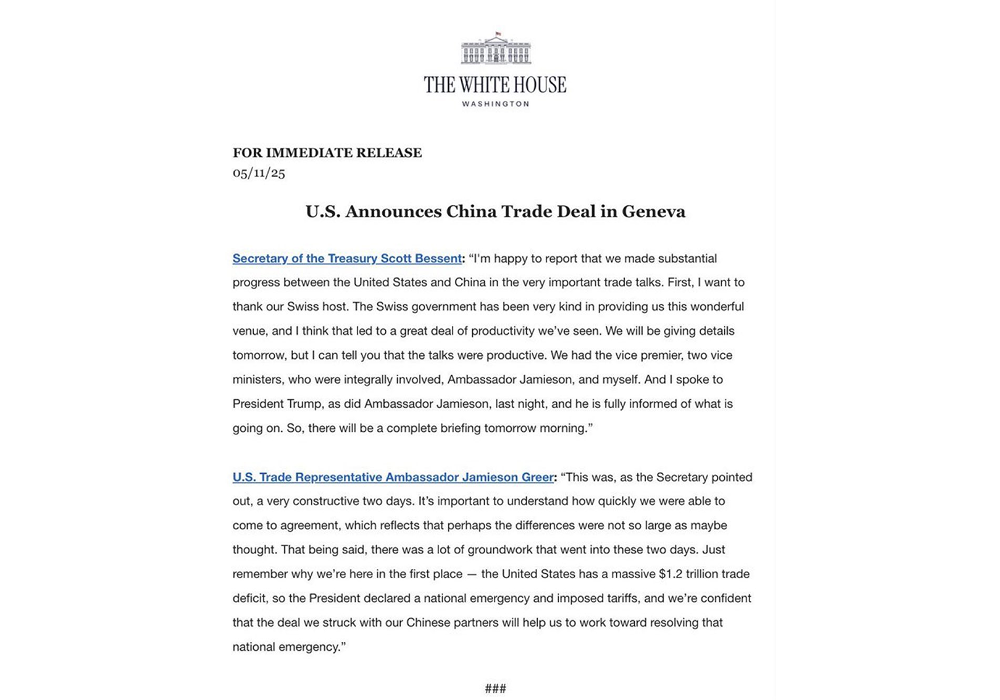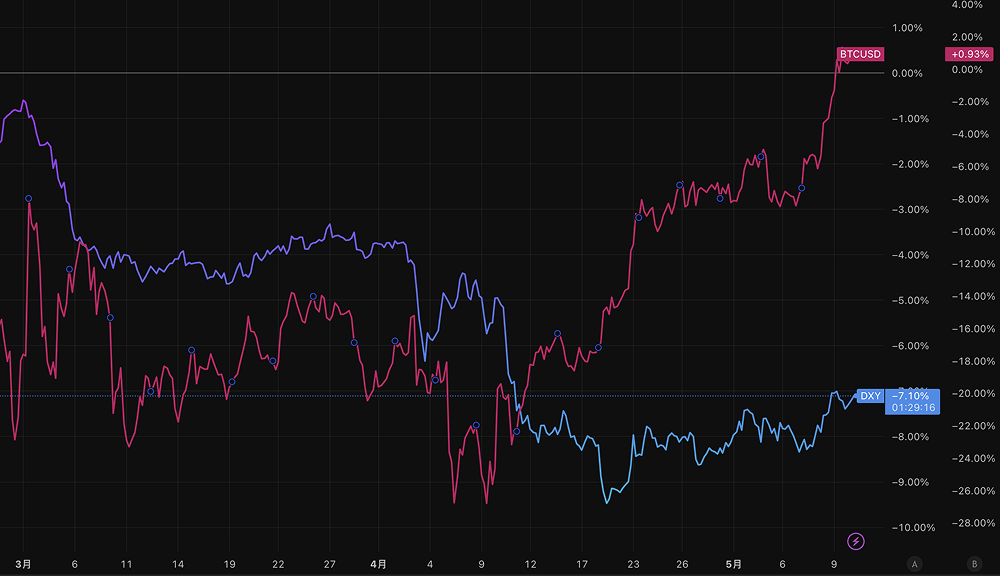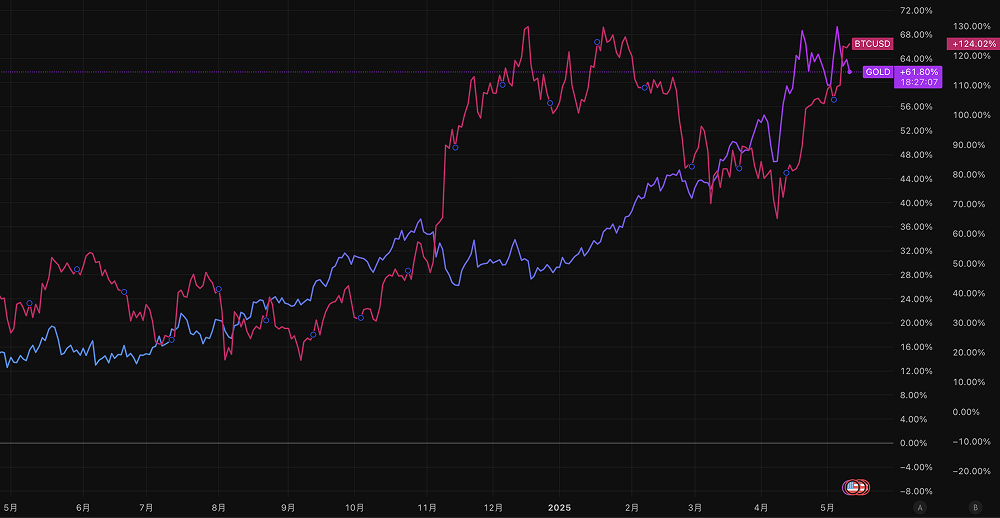On May 12, 2025, the White House issued a statement announcing that the United States had reached a trade agreement with China in Geneva, Switzerland, marking a significant easing of U.S.-China economic and trade relations in recent years. U.S. Treasury Secretary Scott Bessent and U.S. Trade Representative Ambassador Jamieson stated that the negotiations lasted two days, during which both sides made "substantial progress" on key issues, with differences much smaller than expected. This news quickly ignited enthusiasm in global capital markets, and the cryptocurrency market, as a representative of high-volatility risk assets, welcomed new variables and opportunities.

Shift in Dollar Liquidity Expectations: The "Tailwind" for Crypto Assets
The conclusion of the U.S.-China trade agreement has had a profound impact on the global macroeconomic environment. In recent months, market expectations for a strong U.S. dollar index were built on the backdrop of high interest rates and escalating trade frictions. However, the signing of the agreement alleviated tariff pressures, directly weakening the upward risks of inflation. Market analysis on platform X generally believes that this provides the Federal Reserve with greater policy space, potentially accelerating the onset of a rate-cutting cycle or a shift to a dovish stance.
@watson_view pointed out on May 11 that after Trump announced that the U.S.-China talks were "very smooth," Bitcoin's price surged to around $105,000 within an hour. Although it later retreated, market expectations for a weaker dollar have begun to take shape.
The cryptocurrency market is extremely sensitive to the "turning point of dollar liquidity." If the dollar index declines due to expectations of interest rate cuts, funds will be more inclined to flow into high-risk assets, including mainstream cryptocurrencies like Bitcoin (BTC) and Ethereum (ETH), as well as some high-beta altcoins. According to CoinW Research Institute's weekly report on May 19, the total market capitalization of global cryptocurrencies has risen to $3.59 trillion, up 2.5% from the previous week, indicating an accelerating trend of capital inflow. Following the agreement, the market expects the Federal Reserve may cut rates earlier in the third quarter of 2025, and the easing of dollar liquidity will inject new momentum into the crypto market.

Short-term Pressure on Safe-Haven Demand, Long-term Logic Remains Solid
The trade agreement has temporarily weakened the geopolitical risk premium. In the past, when U.S.-China trade frictions escalated, safe-haven assets like gold and Bitcoin often rose due to "safe haven" demand. However, the success of the talks has reduced market concerns about global supply chain disruptions or economic sanctions, putting short-term adjustment pressure on safe-haven assets.
@NewGoX posted on May 12 that the conclusion of the agreement could lead to "good news being fully priced in, then turning bad," suggesting that Bitcoin and gold may face a pullback.
Nevertheless, the long-term logic of cryptocurrencies as "borderless and trustless" assets remains unshaken. The easing of U.S.-China relations is merely a superficial phenomenon; the strategic competition between the two sides in areas such as technology and data sovereignty continues. The decentralized nature of Bitcoin and Ethereum gives them unique value in a global trust crisis. Even if short-term safe-haven demand decreases, crypto assets will still hold a place in global capital allocation as tools to hedge against the depreciation of sovereign currencies and risks in centralized finance.

Speculative Sentiment Heats Up: The "Carnival Moment" for Altcoins and Meme Coins
The conclusion of the agreement has boosted confidence in global capital markets, with rebounds in traditional markets like U.S. and Hong Kong stocks creating a favorable environment for the crypto market. In particular, more speculative altcoins and meme coins may experience a wave of rotation. After Trump's victory in November 2024, the altcoin market saw a widespread surge, with 55% of the top 100 tokens rising over 100%. This agreement may recreate a similar scenario, especially for projects related to narratives like Web3 and AI + blockchain.
It is noteworthy that if the details of the agreement involve technology and data sectors, it could inject new catalysts into the AI + Web3 track. For example, Helio (a Web3 payment platform) and Alterya (a Web3 security platform) secured $170 million and $150 million in funding, respectively, in January 2025, indicating ongoing capital optimism for Web3 infrastructure. If the agreement relaxes restrictions on cross-border data flows, AI + blockchain projects (such as Neur and Beacon Protocol) may become hotspots for capital chasing.
Risks and Uncertainties: Ambiguities in Regulation and Policy
Although the agreement brings multiple benefits to the crypto market, risk factors cannot be ignored. First, the regulatory environment for cryptocurrencies in the U.S. remains unclear. The SEC's lawsuits against unregistered securities tokens and fines against exchanges demonstrate its tough stance. While the Trump administration has relaxed scrutiny on Web3 technologies, the policy inclinations of the new SEC chair may introduce uncertainties. Second, the execution details of the agreement have not been disclosed; if subsequent negotiations encounter reversals on tariff exemptions or technology restrictions, market sentiment could quickly reverse.
Additionally, the centralization risks in the crypto market are intensifying. Large institutions are deeply involved in the crypto market through ETFs and RWAs (real-world assets). If a major player faces a liquidity crisis, it could trigger systemic risks. Investors need to be cautious of the pullback risks under the short-term speculative frenzy, especially regarding the bubble tendencies of meme coins and low-market-cap altcoins.
The conclusion of the U.S.-China Geneva trade agreement has opened a new window for the cryptocurrency market. Expectations of easing dollar liquidity, rising speculative sentiment, and potential catalysts from Web3 narratives collectively constitute multiple benefits for the market. However, the short-term decline in safe-haven demand, regulatory uncertainties, and centralization risks remind investors to remain cautious while pursuing opportunities.
This article represents the author's personal views and does not reflect the position or views of this platform. This article is for informational sharing only and does not constitute any investment advice to anyone.
Join our community to discuss this event
Official Telegram community: t.me/aicoincn
Chat room: Wealth Group
免责声明:本文章仅代表作者个人观点,不代表本平台的立场和观点。本文章仅供信息分享,不构成对任何人的任何投资建议。用户与作者之间的任何争议,与本平台无关。如网页中刊载的文章或图片涉及侵权,请提供相关的权利证明和身份证明发送邮件到support@aicoin.com,本平台相关工作人员将会进行核查。




